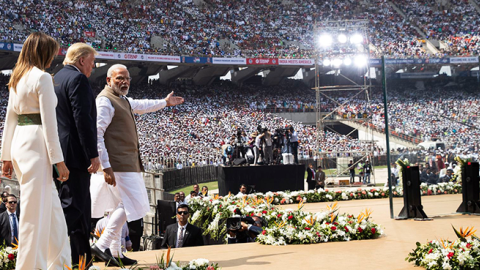President Trump visits India on February 24 and 25, and one centerpiece of his trip is a modest trade deal with the world’s biggest democracy. India has been growing at an average of 7 percent in total output the past decade, but the continued emergence of its $2.7 trillion economy is facing real headwinds, most of which are self-generated. It remains the most closed major economy in the democratic world, and the "reported scope of the likely trade deal":https://www.hindustantimes.com/india-news/right-deal-or-no-deal-says-tr… will not change its trajectory by very much. The potential long-term benefit of Trump’s trip to India and of Prime Minister Narendra Modi’s shared intent to put Indo-American relations on a more robust footing lies elsewhere.
The People’s Republic of China (PRC) has been rapidly overtaking India as the leading economic power and pacesetter in India’s own neighborhood and elsewhere in Asia. If Trump’s visit is followed up in coming years by a concerted effort to keep South Asia free of PRC dominance, gradually open India’s economy, and help pave the way for better Indian economic integration with Southeast Asia and the rest of the global economy, it could bring about the larger geopolitical shift needed to help preserve an intra-Asian power balance that both India and the U.S. want. In the near term, one key to catalyzing closer Indo-American ties is the most dynamic and internationally connected element of the Indian economy, its technology sector.
After independence from Britain in 1947, India was preeminent in Asia, yet its leading position soon began to slip as India failed to keep pace with other Asian nations. In the 1950s, Japan, South Korea, Taiwan, and Singapore began to rapidly develop their economies and later emerged as engines of global economic prosperity. By 1980, even Communist-ruled China was following suit; today, the PRC economy is five times bigger than India’s, and it is second only to that of America in terms of overall size. PRC state capitalism is now directly challenging India’s traditional economic strength in South Asia. In Southeast Asia, meanwhile, total output in the ten countries of the Association of Southeast Asian Nations (ASEAN) is larger than that of India by roughly 10 percent, and Chinese trade in goods with ASEAN is six times that of India.
Prime Minister Modi and his Bharatiya Janata Party were first elected to form a national government in 2014 with the ambition to reverse India’s historical decline relative to other Asian countries. Unfortunately, the Modi government, which was reelected in 2019, "has not delivered":https://www.forbes.com/sites/suparnadutt/2017/07/24/missing-the-mark-pm… on its campaign promises of spurring domestic manufacturing and sustainable growth. India’s managed and highly protected economy "remains a barrier":https://www.ft.com/content/25900f14-1564-11e8-9c33-02f893d608c2 to its breakout and integration into the global economy. Officials in New Delhi say their country must strive to become a 10-trillion-dollar economy just to absorb the upwards of 13 million young people entering India’s labor force every year. Yet, instead of generating sufficient new jobs, Modi’s Hindu-nationalist-led government has been short on concrete actions for integrating India with the global economy led by the advanced democracies, and long on internal politicking and ideology.
At almost 14 percent, average applied tariffs in India are the "highest of any major economy":https://search.yahoo.com/search?p=ustr+barriers+to+foreign+trade&fr=yse…. Tariffs on manufactured goods such as medical products, motorcycles, and agricultural products, and limits on many services imports, are prohibitive. The expected trade deal would reduce some of the most damaging of these impediments to U.S. exporters. Total trade between the U.S. and India is only $145 billion, less than half of the total for the U.S. and the ten countries of ASEAN, and barely 20 percent of total U.S. trade with China.
Against this backdrop, one important factor in the calculus of Trump and Modi to improving bilateral relations, including in the economic sphere, is clearly India’s longstanding fear of being subordinated in an Asia dominated by the PRC. The PRC aims to establish itself as the controlling power in the Western Pacific and the Strait of Malacca, as well as in the Indian Ocean and the Sea of Bengal, through which India connects to Southeast Asia. India already has seen its traditional trade sea lanes threatened by the creation of PRC ports or bases in Sri Lanka, Pakistan, Southeast Asia, and East Africa. Throughout South Asia, PRC is an aggressive presence challenging the autonomy and economies in what Modi and his party consider integral parts of India’s rightful civilizational sphere of influence.
Meanwhile, PRC companies such as Huawei and ZTE are striving to dominate the future of global telecommunications, including 5G. India and the ASEAN countries have been looking to 5G to jump-start economic growth, including via future artificial intelligence (AI) applications. Human-centric AI that is democratically deployed has the potential to help South and Southeast Asian countries to address their creaky governing systems, which are being stressed by rising populations and other dynamics. But Chinese Communist Party dominance over the infrastructure through which data flows could have adverse implications for overall economic growth and competitiveness, while PRC’s surveillance and espionage via 5G could also impinge on the political sovereignty of India as well as other Asian nations.
President Trump and Prime Minister Modi will certainly discuss these challenges posed by the PRC. Over time, the U.S. would like to enlist India as a more active diplomatic and military contributor to the free and open order in the Indo-Pacific. If India is going to play this role, and check the growth of PRC power in South Asia, it will require a larger and faster-growing economy.
Hopefully, Trump’s visit and a likely U.S.–India “mini-deal” will mark a start in the direction of a gradual change. A key element that could motivate closer U.S.–India economic ties is cooperation and trade in high-technology goods and services. The most sophisticated and globally integrated sector of the Indian economy is certainly in areas such as software, information technology, and all the newer services associated with the information economy. Leading U.S. firms such as Microsoft and Google have long had a presence in India for research and development as well as sales. Computer services represent the leading Indian export to the United States. Research-and-development services, pharmaceuticals, and management consulting are all in the top ten of India’s exports to the U.S.
The U.S. and India share a special interest in preventing the PRC from dominating the global telecommunications sector. India’s ambition in manufacturing plausibly includes telecommunications products and related technologies. Korean firm Samsung, another leader in 5G, has "moved":https://tecoholic.com/samsung-makes-a-move-to-india-and-vietnam-after-o… mobile-phone and display-panel production to India, building the largest single phone-production facility in the world in Uttar Pradesh after having moved out of China. Local production will compete in India with low-cost Chinese mobile-phone operators and producers Oppo, Vivo, and Xiaomi, in addition to Huawei. Apple too has an important research facility in India. In time, the "innovation and deployment":https://www.wsj.com/articles/there-is-a-better-alternative-to-huawei-11… of virtualized 5G networks could displace Huawei entirely by using a variety of software and systems-engineering firms from India as well as the U.S. and Japan. Unlike 5G systems based on hardware made in the PRC, joint ventures between India and other democracies could create virtual networks that would help ensure that India’s elected government maintains sovereignty over Indian data while enabling greater international cooperation and commerce.
Strategic rivalry and the decoupling of the Chinese and American economies present a clear opportunity for India. If India and the U.S. can build on the promising early examples of cross-fertilization and cooperation in high tech, this would help build confidence for broader economic and trade opening in years ahead. The Trump–Modi summit could represent a major step toward this longer-term goal if they decide to open talks on technology trade and standard-setting, rules for digital trade and services, and democratic cooperation in research in areas such as new telecommunications systems and AI. Meeting the Chinese Communist challenge will never be far from the concrete agenda, and India and the U.S. have much to offer each other and much to gain by pivoting to their strengths in the high-technology and digital sectors.
Read in "National Review":https://www.nationalreview.com/2020/02/us-india-trade-relations-trump-v….





















